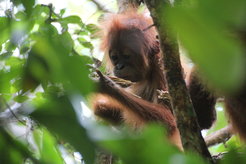Wild and zoo-housed orangutans explore the world differently
Zoo life boosts object exploration in orangutans, study finds

To the point
- Orangutans in zoos explore more frequently and in more varied ways than those in the wild, including greater use of tools and multiple objects.
- While orangutans in both settings began using the different types of explorations at similar ages, zoo individuals continued exploring at high frequencies into adulthood, unlike wild ones whose exploration declined likely due to survival demands.
- The environment profoundly affects not only human development but also the behavior and cognition of our closest relatives.
A new study comparing wild and zoo-housed Sumatran orangutans reveals that life in a zoo significantly alters how orangutans interact with their environment. Researchers analyzed over 12,000 instances of daily exploratory object manipulation (EOM)—the active manipulation and visual inspection of objects associated with learning and problem-solving—across 51 orangutans aged 0.5 to 76 years. The findings show that orangutans living in zoos engage in more frequent, more diverse, and more complex exploration than their wild counterparts.
“Our study shows that orangutans in zoos not only explore more, but they also explore differently,” said Isabelle Laumer, first author of the study. “What’s especially fascinating is that even when exploring the same kinds of objects, zoo-housed orangutans showed a richer repertoire of actions and were more likely to use tools or manipulate multiple objects at the same time.”
The study compared EOM behaviors in wild and zoo-housed orangutans across a wide age range. Data were collected at the Suaq Balimbing research site in Indonesia from 33 wild individuals aged between six months and 76 years and at four zoos in Germany and Switzerland from 24 individuals aged between seven months and 49 years.
A video of wild and zoo-housed orangutans during exploratory object manipulation
The study showed that zoo-housed orangutans explore the objects in their surroundings more frequently than wild orangutans whilst there was no difference in exploration duration when individuals did explore. Wild orangutans primarily explored naturally occurring objects like plants, bark, and sticks, while zoo-housed orangutans engaged with a wider variety of enrichment items such as plastic toys, puzzles, and stackable objects designed to encourage manipulation and cognitive engagement. Importantly, the age at which orangutans first engaged in specific types of exploration was consistent across both settings, suggesting an innate developmental sequence. However, zoo orangutans continued to explore into adulthood, while wild individuals’ EOM declined sharply around weaning age at about 8 years of age — likely due to the demands of survival in the wild, where foraging and constant vigilance leave little time for exploration.
In human infants, object exploration enables learning about physical properties such as texture and weight while stimulating cognitive and motor development—a pattern observed in many non-human animals as well. The heightened exploration may enhance cognitive flexibility and problem-solving skills in zoo-housed orangutans, as they interact with varied enrichment items and have more time and energy to devote to learning through exploration.
“These findings underscore how profoundly the environment influences animal behavior and cognitive development,” said Caroline Schuppli, senior author of the study. “And it also offers unique opportunities—by comparing wild and zoo-housed animals, we can better understand the full extent of a species’ cognitive potential.”













